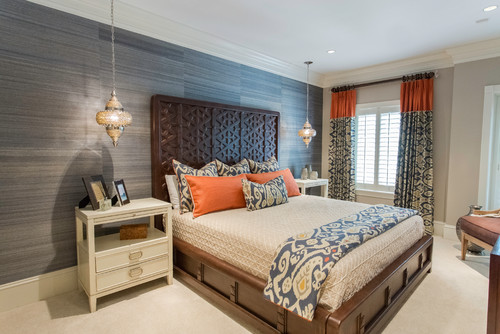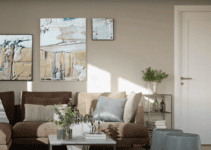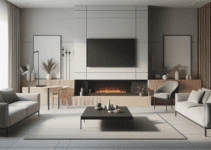If you want to bring an exotic but elegant and charming look to your home perhaps, you should take into consideration the mysterious, luxurious and colorful Moroccan style that combines divinely many styles such as Mediterranean, Arabic and African.

Photo by Lovelace Interiors – Discover bedroom design ideas
Nestled in the North-West corner of Africa, between a sea and a ocean, the Mediterranean and Atlantic and two continents, Africa and Europe, Moroccan style is defined by strong colors, textures and flowing lines, a delightful blend between the eastern Islamic design and the colors of the Sahara sand.
Colours: Moroccan style is characterized by vivid and beautiful colors such as fuchsia, purple, royal blue, strong red, combined with the subtle colors of the desert, such as sandy, white, beige, and gray marks.
Different and Contradictory Textures: Moroccan style is defined essentially by a variety of textures. Thus, in this style can be found rough plaster walls, fine silk tapestries, stone objects, ceramic objects and carved wood furniture.
We can say that Moroccan style is an eclectic style. At a first glance, it relies heavily on discrepancies, on unexpected and inappropriate juxtapositions.
Structural Elements of Interior Design in Moroccan Style: The Moroccan traditional style houses are made of gypsum plaster with beams and wooden pillars.
For the exterior is mainly used white and houses shine in bright light of the African sun. Doors and windows have their top side in the shape of an arc. The strong and blazing North African sun makes the homeowners to spend much of their time outside in the shade of palm trees, and enjoying the beauty of the landscape. Vivid colors are blended with rich adorned furniture, potted plants, many accessories and diffuse light to create an ideal indoor oasis.
Terracotta tiles and ceramic also play a major role in the Moroccan design. These two materials can and are successfully used for framing doors, windows, pictures, mirrors, or paintings on the walls.
Fabrics: Gauze, silk and various draped linen, are used to delimit rooms to emphasize the outline of the windows or to cover the furniture. For these fabrics are used the same bright colors typical of this decorating style.
Furniture: Typical Moroccan style furniture is a combination of pieces of carved wood with velvet-upholstered elements. The tables have the surface made of mosaic, wood, brass or copper.
Upholstered elements may also include sofas covered with pillows and blankets diverse colored in strong Turkish shades.
Accessories: Accessories exemplify of course again the Asian and Islamic influences. Decorative floor mats are made of silk and wool and range from small to large sizes that cover entire surface of the room.
Lamps are usually attached to the ceiling and are made of metals such as brass or copper.
Other sub-branches of Moroccan style include mirrors, often framed in metal or wood with an Islam design.
We also can meet various pottery vessels that are attached to the wall, used either as dishes or kept, only as a decorative element.
Conclusion: A warm and friendly atmosphere characterizes Moroccan style above all. In addition, this style of arrangement does not involve a lot of money.
Just follow the main features and you can soon make an original and enjoyable Moroccan interior.
Mexican Style Interior Design – Colour and Warmth (howtobuildahouseblog.com)


